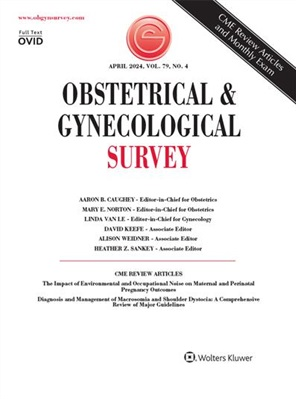Effect of the Endometrial Thickness on the Live Birth Rate: Insights From 959 Single Euploid Frozen Embryo Transfers Without a Cutoff For Thickness
IF 4.3
4区 医学
Q1 OBSTETRICS & GYNECOLOGY
引用次数: 2
Abstract
ABSTRACT Although numerous studies have examined whether endometrial thickness (ET) independently affects the live birth rate (LBR) after an embryo transfer, contradictory conclusions have resulted in an unclear answer. It has been hypothesized that a thin endometrium decreases implantation rates possibly due to elevated oxygen concentration from spiral arteries; however, this mechanism has not been unequivocally demonstrated. This retrospective analysis aimed to investigate whether ET independently affects the LBR after a frozen embryo transfer cycle. All patients who underwent a single euploid blastocyst transfer between March 2017 and March 2020 at a single-assisted reproductive technology clinic were included. Live birth was defined as the delivery of a live fetus after 22 weeks of gestation. Programmed cycle (PC) or natural cycle (NC) for endometrial preparation was conducted at physician’s and patient’s discretion. The presence of a linear relationship between ET and LBR was assessed by conditional density plots (CDPs), and receiver operating characteristics (ROC) curve analyses were used to identify whether a threshold of the ET existed to predict the occurrence of live birth. The CDPs were analyzed for an optimal range of the ET that could be associated with a higher LBR, and the distribution of cycle characteristics and embryo quality in that range were compared with cycles outside of that range to identify confounders. Logistic regression models were constructed separately for the PC and NC. A total of 959 single euploid FETs were included in this analysis, of which 33% (n = 315) were NC and 67% (n = 644) were PC with an overall LBR of 47.1% (452/959). No linear relationship between the ET and LBR or threshold below which the LBR decreased perceivably was identified. In addition, ROC analysis did not suggest a predictive value of the ET for occurrence of live birth based on endometrial preparation or in the overall cohort. Similarly, logistic regression analyses showed no independent effect of the ET on LBR. The results of this study suggest that there is no linear relationship between the ET and LBR or a clinically significant cutoff for ET below which the LBR decreases in FET cycles. Significantly, the common practice of canceling embryo transfers when the ET is <7 mm is not supported by these data.子宫内膜厚度对活产率的影响:来自959例无厚度切断的单整倍体冷冻胚胎移植的见解
尽管许多研究已经研究了子宫内膜厚度(ET)是否独立影响胚胎移植后的活产率(LBR),但相互矛盾的结论导致了一个不明确的答案。据推测,较薄的子宫内膜可能由于螺旋动脉的氧浓度升高而降低着床率;然而,这一机制并没有得到明确的证明。本回顾性分析旨在探讨胚胎移植周期后ET是否独立影响LBR。所有在2017年3月至2020年3月期间在单一辅助生殖技术诊所接受单个整倍体囊胚移植的患者均被纳入研究。活产被定义为妊娠22周后产下一个活的胎儿。子宫内膜准备的程序周期(PC)或自然周期(NC)由医生和患者自行决定。通过条件密度图(CDPs)评估ET与LBR之间是否存在线性关系,并使用受试者工作特征(ROC)曲线分析来确定ET是否存在预测活产发生的阈值。分析CDPs以确定与较高LBR相关的最佳ET范围,并将该范围内周期特征和胚胎质量的分布与该范围外的周期进行比较,以确定混杂因素。对PC和NC分别建立了Logistic回归模型。共纳入959个单倍体fet,其中33% (n = 315)为NC, 67% (n = 644)为PC,总体LBR为47.1%(452/959)。ET与LBR之间没有线性关系,LBR低于阈值时明显下降。此外,ROC分析并未提示基于子宫内膜准备或在整个队列中ET对活产发生的预测价值。同样,逻辑回归分析显示ET对LBR没有独立的影响。本研究的结果表明,ET和LBR之间没有线性关系,也没有临床意义上的ET临界值,低于该临界值,LBR在FET周期中会下降。值得注意的是,这些数据不支持当ET为7 mm时取消胚胎移植的常见做法。
本文章由计算机程序翻译,如有差异,请以英文原文为准。
求助全文
约1分钟内获得全文
求助全文
来源期刊
CiteScore
2.70
自引率
3.20%
发文量
245
审稿时长
>12 weeks
期刊介绍:
Each monthly issue of Obstetrical & Gynecological Survey presents summaries of the most timely and clinically relevant research being published worldwide. These concise, easy-to-read summaries provide expert insight into how to apply the latest research to patient care. The accompanying editorial commentary puts the studies into perspective and supplies authoritative guidance. The result is a valuable, time-saving resource for busy clinicians.

 求助内容:
求助内容: 应助结果提醒方式:
应助结果提醒方式:


